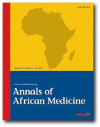
|
Annals of African Medicine
Annals of African Medicine Society
ISSN: 1596-3519
Vol. 4, No. 4, 2005, pp. 168-171
|
 Bioline Code: am05042
Bioline Code: am05042
Full paper language: English
Document type: Research Article
Document available free of charge
|
|
|
Annals of African Medicine, Vol. 4, No. 4, 2005, pp. 168-171
| fr |
Jiya, N. M.; Matazu, I. K.; Bilbis, L. S. & Shehu, R. A.
Résumé
Contexte:
L'anémie drépanocytaire est l'un des plus fréquents problèmes de santé chez l'enfant au Nigeria.
Méthode :
Le taux sérique d'anti oxydants, vitamine A (rétinol), vitamine C (acide ascorbique) et vitamine E (alpha-tocopherol) a été déterminé chez des enfants présentant une association hémoglomine fetale - anémie drépanocytaire persistante (Hb SS + F), une drépanocytose (Hb SS) et une hémoglobine normale (Hb AA).
Résultats :
Le taux de vitamines anti oxydants n'était pas significativement différente entre les enfants présentant une Hb SS+F et ceux présentant une Hb SS (p>0.05). Par contre ce taux de vitamines est significativement plus élevé chez les enfants à Hb normal (AA) comparés à ceux ayant une Hb SS+F et SS (p<0.05). La faible baisse du taux de vitamines anti oxydants chez les enfants à Hb SS+F pourrait s'expliquer par la relative moindre fréquence des crises de drépanocytose souvent retrouvée chez ces enfants.
Conclusion:
La faible baisse du taux de vitamines anti oxydants chez les enfants à Hb SS+F pourrait constituer un facteur contribuant à leur relative stabilité sur le plan clinique. Il est donc recommandé de mettre les enfants à Hb SS+F et SS sous traitement anti oxidant: A, C et E.
Mots Clés
Anémie drépanocytaire, hémoglobine foetale, vitamine sérique A, vitamine sérique C, vitamine sérique E
|
| |
| en |
Serum Levels of Antioxidant Vitamins in Foetal Haemoglobin (HbF) Persistent Sickle Cell Anaemia Children in Sokoto, Nigeria
Jiya, N. M.; Matazu, I. K.; Bilbis, L. S. & Shehu, R. A.
Abstract
Background:
sickle cell anaemia (SCA) is one of the commonest health problems of Nigerian children.
Method:
The serum levels of antioxidant vitamins A (retinol), C (ascorbic acid) and E (alpha-tocopherol) were determined in foetal haemogbobin persistent sickle cell anaemic (Hb SS + F), sickle cell anaemic (Hb SS) and normal (Hb AA) children.
Results:
The levels of antioxidant vitamins in Hb SS+F children were found to be insignificantly different (p>0.05) when compared to those of Sickle Cell anaemic (Hb SS) children. While significantly higher values (p<0.05) of the vitamins in normal children (Hb AA) were observed when compared to those in HbSS+F and Hb SS children. The slightly less depressed levels of the antioxidant vitamins in Hb SS+F children may probably be attributed to the relatively less frequent sickle- cell crises often found in these individuals.
Conclusion:
The less depressed serum levels of anti-oxidant vitamins in HbSS + F children may be contributory factor to their relatively stable clinical status. Therefore, it is recommended that HbSS + F children as well as HbSS children be placed on regular anti-oxidant vitamins - A, C and E supplement.
Keywords
Sickle cell anaemia, foetal haemogbobin, serum vitamin A, serum vitamin C, serum vitamin E
|
| |
© Copyright 2005 - Annals of African Medicine
Alternative site location: http://www.annalsafrmed.org
|
|
